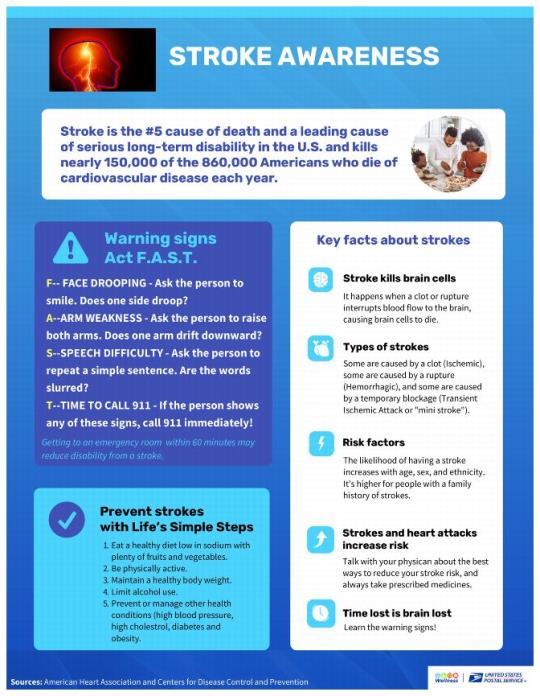May is Stroke Awareness Month, a time to learn about stroke symptoms and prevention. Often referred to as brain attacks, strokes occur when blood supply to the brain is blocked or a blood vessel in the brain bursts.
A stroke can lead to brain damage, disability, and death, and it is the leading cause of serious, long-term disability. Any person, including a child, can have a stroke at any time.
Common signs of a stroke include:
n Sudden dizziness or trouble walking;
n Loss of balance;
n Trouble seeing in one or both eyes;
n Sudden severe headache;
n Sudden numbness of the face, arm, or leg; and
n Sudden confusion or trouble understanding others.
An easy way to remember the most recognizable signs of stroke and how to respond is with the acronym, F.A.S.T.:
n F = Face drooping. Ask the person to smile. Does one side droop?
n A = Arm weakness. Ask the person to raise both arms. Does one arm drift down?
n S = Speech difficulty. Ask the person to repeat a simple sentence. Is their speech slurred or strange?
n T = Time to call 911. If the person shows any of these signs, call 911 immediately.
Strokes are a medical emergency, and stroke treatment and outcomes depend on how fast you get to the hospital and which type of stroke you had. Strokes are largely preventable with healthy lifestyle behaviors. High blood pressure is the single most important treatable risk factor for stroke.
To reduce your risk factors for a stroke:
n Maintain a healthy weight and eat nutritious food;
n Be physically active;
n Don’t smoke and limit alcohol use; and
n Manage your health conditions, especially high blood pressure, high cholesterol, diabetes, and obesity.
The information in this article does not constitute medical advice. Consult your doctor for the best ways to reduce your risk of a stroke.
For more information about stroke prevention, visit:
n The Centers for Disease Control and Prevention at cdc.gov/stroke/index.htm.
n USPS® Wellness page at liteblue.usps.gov/humanresources/benefits/health-wellness/welcome.htm.
— Benefits and Wellness,
Human Resources, 5-5-22

